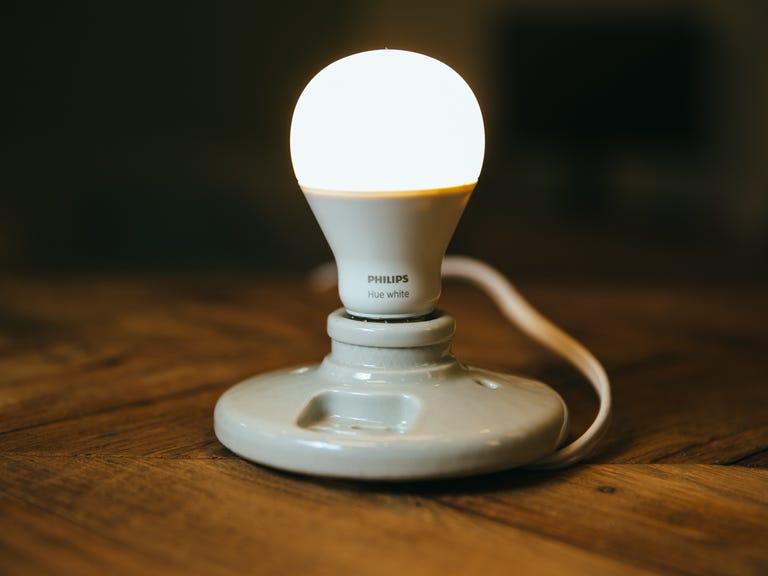 Why You Can Trust CNET
Why You Can Trust CNET Philips Hue White LED Starter Kit review: Hue's cheapest LED kit is a rock-solid foundation for smart lighting
It's counterintuitive, but the white-light-only Philips Hue bulbs represent serious smart-home value thanks to the power of the Philips Hue platform.
There's an awful lot to like about Philips Hue's smart lighting ecosystem. It's polished. It's easy to use. It works with just about everything. The only problem? The price. A starter kit with the essential Philips Hue Bridge and three color-changing bulbs costs $180 -- a steep point of entry for connected lighting.
The Good
The Bad
The Bottom Line
Fortunately, that color-changing kit isn't your only option. For $70, Philips also sells a starter kit with that same Hue Bridge and a pair of plain, soft white smart bulbs. They won't change colors at all, but you can still automate them to turn on and off or dim up and down, and they'll work with all of the same third-party services as the rest of the Hue lineup, including Amazon's Alexa, Apple HomeKit, IFTTT, the Nest Learning Thermostat and more. Plus, given that the Hue Bridge typically sells for about $60 on its own, you're basically getting them for $5 each if you buy the kit, which is a heck of a deal.
All of that makes the Philips Hue White LED Starter Kit a near must-have for anyone who's serious about connected lighting and a very safe purchase given how good Philips has been about keeping its bulbs up to date with the latest platforms and products.
Let's talk light bulbs
The Philips Hue White LEDs are good light bulbs in their own right. Each one puts out over 800 lumens at full brightness, making them a fair replacement for a standard 60W incandescent. They're efficient, too, putting that light out from a power draw of just 9.5 watts. That's excellent, especially for a connected LED that's doing more than just emitting light.
If you take a look at the shape of the bulb itself, you'll see that it's nice and wide, extending out beyond the heat sink that makes up the bottom half. That gives it a nice, omnidirectional light output that can shine downward if you're using it in something like a bedside reading lamp. To me, that's a slight edge over the Lifx White 800 LED. Though the Lifx is a brighter bulb overall, its flat-topped design that falls flush with the base of the bulb prevents the bulb from casting as much downward light as it should.
The Philips Hue White LED does a great job of casting light out evenly in all directions.
The Philips bulb also dims exceptionally well, going all the way down to 0.9 percent brightness at its minimum setting (about 7 lumens). And because it's using in-bulb dimming smarts as opposed to relying on in-wall dimmer switches, you won't have to worry about flicker or buzz. Just be sure not to use it with one of those in-wall dimmer switches, as the two dimming mechanisms will clash and cause the bulb to strobe.
Smart lighting at its most versatile
So, how do you dim a light bulb if not with a dimmer switch? You've got a couple of options. First, there's the Philips Hue app, which will let you dim lights or groups of lights on your Android or iOS device. For physical controls, you could also pick up the Philips Hue wireless dimming remote, which nestles into a wall-mounted holder and can control up to 10 bulbs at a time.
Then, there are those third-party integrations that are so, so important to the Philips Hue pitch. You could, for instance, pair your bulbs with Alexa, the voice-activated virtual assistant in the Amazon Echo smart speaker, then ask her to dim them down to whatever setting you like. Same goes for Siri, since the latest, square-shaped version of the Hue Bridge works with Apple HomeKit. You could also use the free online service IFTTT to trigger your lights to dim automatically at a specific time.
We've tested just about all of Philips Hue's integrations in the CNET Smart Home, where you'll find the Philips Hue White LED in pretty much every lamp we own. After months and months of use, it's been one of the most reliable and easy to use systems that we've installed and tested.
The verdict
It's a bit ironic, but I like Philips Hue best when it ditches the colors. At $70, its white-light-only smart bulb kit is a very solid value -- much, much more so than the $200 color-changing kit. And once you've got that Philips Hue Bridge hooked up to your router, you can add additional bulbs a la carte style, including a color-changer or two if that's what you want. Even if you buy two of those color-changing Hue bulbs to add to your setup, you'll still be spending less than you would on the color-changing starter kit.
The bottom line: Hue is worth buying into if you want a rock-solid smart lighting platform in your home, and the Philips Hue White LED Starter Kit is your most affordable entry point. It's an easy recommendation for just about anyone with an interest in smart lighting.


